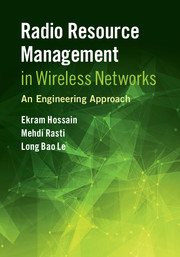Book contents
- Frontmatter
- Contents
- Preface
- Part I Basics of Wireless Networks
- Part II Techniques for Modeling and Analysis of Radio Resource Allocation Methods in Wireless Networks
- Part III Physical Layer Resource Allocation in Wireless Networks
- 5 General System Model and Preliminary Concepts
- 6 Power Control in Cellular Wireless Networks
- 7 Distributed Joint Power and Admission Control
- 8 Joint Power and Admission Control in Cognitive Radio Networks
- 9 Cell Association in Cellular Networks
- Part IV Link Layer Resource Allocation in Wireless Networks
- Part V Cross-Layer Modeling for Resource Allocation in Wireless Networks
- Index
- References
9 - Cell Association in Cellular Networks
from Part III - Physical Layer Resource Allocation in Wireless Networks
Published online by Cambridge University Press: 11 May 2017
- Frontmatter
- Contents
- Preface
- Part I Basics of Wireless Networks
- Part II Techniques for Modeling and Analysis of Radio Resource Allocation Methods in Wireless Networks
- Part III Physical Layer Resource Allocation in Wireless Networks
- 5 General System Model and Preliminary Concepts
- 6 Power Control in Cellular Wireless Networks
- 7 Distributed Joint Power and Admission Control
- 8 Joint Power and Admission Control in Cognitive Radio Networks
- 9 Cell Association in Cellular Networks
- Part IV Link Layer Resource Allocation in Wireless Networks
- Part V Cross-Layer Modeling for Resource Allocation in Wireless Networks
- Index
- References
Summary
Introduction
One of the important issues in infrastructure-based multi-cell wireless networks is properly associating mobile user equipments (UEs) to the serving BSs. In the literature, this is usually referred to as user association, cell association, cell selection, or BS assignment. We will use the term “cell association” in this chapter. Obviously, in a wireless network with dense deployment of the BSs, the number of potential BSs with which a UE can be associated is increased. The network densification necessitates the need for designing optimal and/or distributed cell association (BSs assignment to UEs) schemes. This is because, if the UEs are not properly associated with BSs, it may result in reduced throughput, increased interference, inefficient energy consumption, and load imbalance, in uplink and/or downlink.
In Chapters 6 and 7, it was assumed that cell association is already performed (i.e., fixed BS assignment). In fact, in those chapters a fixed cell association is assumed, under which the power control and joint power and admission control problems were defined and addressed. In this chapter, we assume the BS assigned to each UE is not fixed and can be dynamically determined.
Cell association can be performed separately or jointly with other resource allocation schemes. For instance, cell association can be performed based on some metric such as the received (pilot) signal strength, or it can be performed jointly with power control or channel allocation. In this chapter, we first briefly present the system model introduced in Chapter 5 and make a little change in notations to make it suitable for studying the problem of dynamic cell association. Then the joint cell association and power control (CAPC) schemes are studied, followed by a review of the existing approaches for distributed cell association schemes (where cell association is performed separately and independently from the power control). Finally, open challenges and problems are discussed.
System Model and Notations
We consider the same system model presented in Chapter 5, which is briefly introduced again in this chapter.
- Type
- Chapter
- Information
- Radio Resource Management in Wireless NetworksAn Engineering Approach, pp. 276 - 288Publisher: Cambridge University PressPrint publication year: 2017
References
- 1
- Cited by



